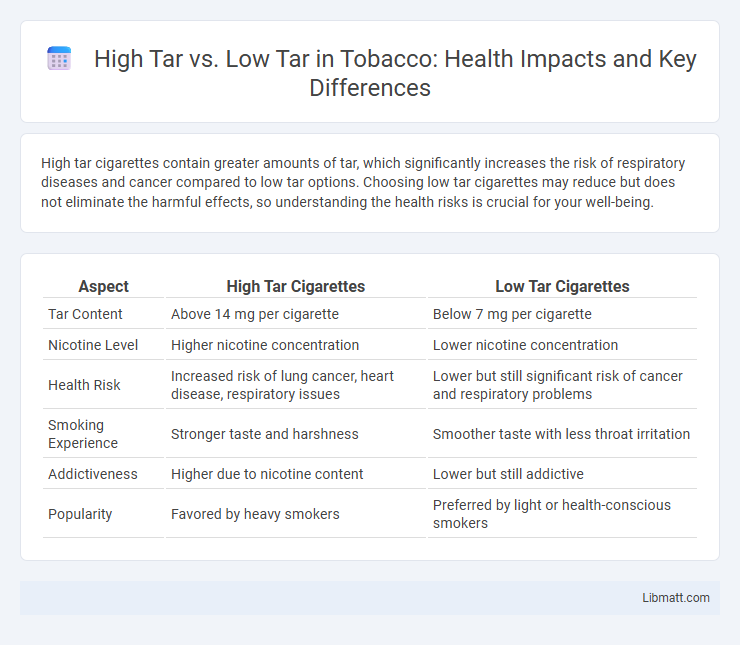High tar cigarettes contain greater amounts of tar, which significantly increases the risk of respiratory diseases and cancer compared to low tar options. Choosing low tar cigarettes may reduce but does not eliminate the harmful effects, so understanding the health risks is crucial for your well-being.
Table of Comparison
| Aspect | High Tar Cigarettes | Low Tar Cigarettes |
|---|---|---|
| Tar Content | Above 14 mg per cigarette | Below 7 mg per cigarette |
| Nicotine Level | Higher nicotine concentration | Lower nicotine concentration |
| Health Risk | Increased risk of lung cancer, heart disease, respiratory issues | Lower but still significant risk of cancer and respiratory problems |
| Smoking Experience | Stronger taste and harshness | Smoother taste with less throat irritation |
| Addictiveness | Higher due to nicotine content | Lower but still addictive |
| Popularity | Favored by heavy smokers | Preferred by light or health-conscious smokers |
Understanding Tar Content in Tobacco Products
Tar content in tobacco products directly influences the level of harmful chemicals you inhale, with high-tar cigarettes typically delivering greater amounts of toxins compared to low-tar alternatives. Understanding the differences helps in evaluating the potential health risks, as tar contains carcinogens linked to lung cancer and respiratory diseases. Choosing products with lower tar content can reduce exposure but does not eliminate the risks associated with smoking.
What is High Tar?
High tar refers to tobacco products that contain a larger amount of tar, a sticky substance composed of various harmful chemicals produced when tobacco is burned. This increased tar content significantly raises the risk of respiratory diseases, lung cancer, and other serious health issues. Understanding high tar levels can help you make informed choices about smoking and potential health consequences.
What is Low Tar?
Low tar refers to cigarettes or tobacco products that contain reduced amounts of tar, a harmful residue produced during smoking. Tar consists of numerous carcinogens and toxins responsible for respiratory diseases and cancer, making low tar variants a supposedly less harmful option. Despite lower tar levels, health risks remain significant, underscoring that no cigarette is safe.
Health Risks of High Tar Cigarettes
High tar cigarettes contain significantly higher levels of tar, a toxic residue that contributes to lung damage, chronic bronchitis, and increased risk of lung cancer. Studies show that smokers of high tar cigarettes are more likely to develop cardiovascular diseases and respiratory complications due to greater exposure to carcinogens. Reducing tar intake by switching to low tar cigarettes can decrease but not eliminate the risk of serious health problems associated with smoking.
Health Risks of Low Tar Cigarettes
Low tar cigarettes are often perceived as a safer alternative, but they still pose significant health risks, including an increased chance of lung cancer, chronic obstructive pulmonary disease (COPD), and cardiovascular diseases. Smokers may compensate for lower tar by inhaling more deeply or smoking more cigarettes, negating any potential benefits. Research shows that low tar levels do not reduce exposure to harmful toxins and carcinogens, sustaining similar levels of health hazards as regular cigarettes.
Smoking Experience: High Tar vs Low Tar
High tar cigarettes deliver a stronger, more intense smoking experience due to the higher nicotine and tar content, resulting in a heavier throat hit and more pronounced flavor. Low tar cigarettes provide a smoother, milder taste with reduced harshness, appealing to smokers seeking less irritation and lower nicotine intake. Research indicates that despite lower tar levels, smokers may compensate by inhaling more deeply or smoking more frequently, affecting overall exposure to harmful substances.
Regulatory Standards for Tar Levels
Regulatory standards for tar levels in cigarettes vary globally, with many countries setting maximum allowable limits to reduce health risks associated with smoking. Low tar cigarettes are designed to meet these regulatory requirements by significantly reducing tar content compared to high tar variants, which contain higher concentrations of harmful substances. Understanding these regulations can help you make informed decisions and prioritize products that comply with stringent tar level standards to minimize exposure to toxic compounds.
Misconceptions About Low Tar Cigarettes
Low tar cigarettes are often misunderstood as a safer alternative to high tar cigarettes, but research shows they still deliver harmful toxins and carcinogens. Studies reveal that smokers may inhale more deeply or smoke more frequently with low tar cigarettes to maintain nicotine intake, negating potential benefits. Health organizations emphasize that no cigarette is safe, regardless of tar content, and quitting smoking remains the most effective way to reduce health risks.
Consumer Trends and Preferences
Consumer trends indicate a growing preference for low tar cigarettes due to health concerns and increasing awareness of smoking risks. Market data shows a significant shift as smokers seek products with reduced tar levels to minimize exposure to harmful chemicals without compromising their smoking experience. Your choices reflect a broader demand for alternatives that balance satisfaction with perceived wellness benefits.
Making an Informed Choice: High Tar vs Low Tar
Choosing between high tar and low tar cigarettes involves evaluating the health risks and personal preferences associated with each type. High tar cigarettes deliver greater levels of harmful chemicals, increasing the risk of respiratory diseases and cancer, while low tar options reduce some exposure but still pose significant health dangers due to nicotine and other toxins. Understanding tar content, along with individual smoking habits and addiction levels, is crucial for making an informed decision that balances risk and satisfaction.
high tar vs low tar Infographic

 libmatt.com
libmatt.com